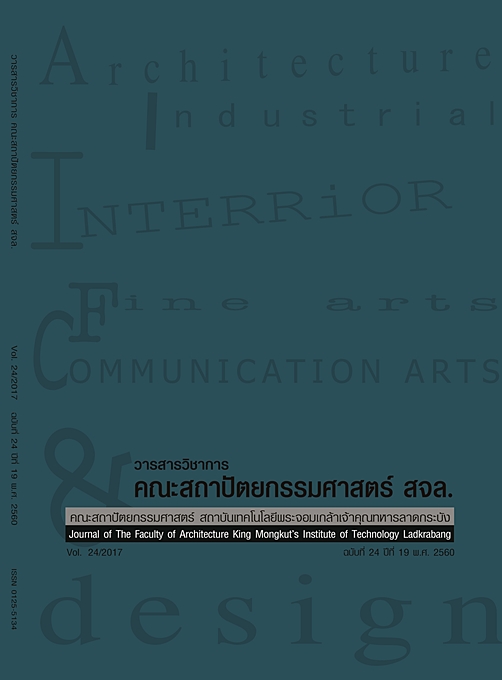การพัฒนาผลิตภัณฑ์ของที่ระลึกเพื่อแสดงเอกลักษณ์ท้องถิ่นหลวงพระบาง: The Development of Souvenirs to Represent the Luang Prabang Local Identity
Main Article Content
Abstract
งานวิจัยนี้มีวัตถุประสงค์เพื่อศึกษาเอกลักษณ์ท้องถิ่นหลวงพระบางเพื่อนนำเสนอการบูรณาการแนวคิดเศรษฐกิจสร้างสรรค์สู่การพัฒนาผลิตภัณฑ์ของที่ระลึกด้วยต้นแบบที่แสดงเอกลักษณ์ท้องถิ่นหลวงพระบาง กลุ่มตัวอย่างคือนักท่องเที่ยวชาวหลวงพระบางและต่างประเทศ ผู้ผลิตของที่ระลึกในพื้นที่บ้านผานม บ้านดอนแก้ว บ้านสั่งฆ้องและบ้านจ่านเหนือ เก็บรวบรวมข้อมูลด้วยการสอบถาม สัมภาษณ์ วิเคราะห์ข้อมูลด้วยสถิติพรรณา ร่างแบบและสร้างต้นแบบด้วยการบูรณาการแนวคิดเศรษฐกิจสร้างสรรค์คือความคิดสร้างสรรค์และการสร้างมูลค่า ผลพบว่าเอกลักษณ์ที่ทำให้เกิดการจดจำและยอมรับคือวัดเซียงทอง
ด้วยส่วนที่จับต้องได้หรือเอกลักษณ์เชิงรูปธรรม คือ สถาปัตยกรรมและศิลปกรรมที่ถ่ายทอดผ่านรูปแบบหลังคาซ้อน 3 ตับด้านเฉียงและด้านหน้าของวัดเซียงทอง และ รูปแบบศิลปกรรมที่ตกแต่งด้วยกระจกหลากสีบนพื้นแดง ส่วนที่จับต้องไม่ได้หรือเอกลักษณ์เชิงนามธรรมคือ เรื่องเล่าประวัติศาสตร์ ประเพณีและพิธีกรรม ผู้วิจัยลดทอนรายละเอียดของสิ่งที่สื่อแทนเอกลักษณ์ด้วยรูปร่างรูปทรง ลวดลาย และสี 8 สี คือ เหลืองอ่อน เหลืองเข้ม น้ำตาลเข้ม ชมพู แดง เขียวเข้ม ฟ้า และน้ำเงิน ต้นแบบของผลิตภัณฑ์ของที่ระลึกคือ หมวก เสื้อยืด แก้วน้ำ กระเป๋า เครื่องประดับหู เครื่องนอน ผ้าพันคอ โปสเตอร์และโปสการ์ด ซึ่งตรงตามพฤติกรรมการเลือกซื้อสินค้าที่ระลึกและความต้องการของนักท่องเที่ยวหลวงพระบาง
คำสำคัญ: ของที่ระลึก แนวคิดเศรษฐกิจสร้างสรรค์ เอกลักษณ์ท้องถิ่น หลวงพระบาง
Abstract
The research aims to study the identity of Luang Prabang integrating the creative economy with the design process to develop the souvenirs that represent this local identity. Samples are Luang Prabang and foreign tourists and the craftsmanship at Ban Pa-nom, Ban Don-kaew, Ban Sang-kong and Ban Jan-Neung. Researchers collect the data by questionnaire and interview, and analyze the data with descriptive statistic. Then, sketch and create the souvenir prototypes by integrating the creative economy with the creativity and value creation. The results show that the local identity recognized and accepted is Wat Xieng Thong. The tangible identity is architecture and fine arts through three overlapping forms on the oblique and front of roof, the art decorate with colored glass on the red background. The intangible identity is the narrative history, traditions and rituals. Researchers reduce the details that represent local identity by shape, form, pattern and 8 colors: light yellow, dark yellow, dark brown, pink, red, dark green, light blue and cobalt blue. The prototypes are hats, t-shirts, mugs, bags, jewelry, bedding, scarves, poster and postcard, consistenting with buying behaviors and the needs.
Keywords: Souvenirs, Creative Economy, Local Identity, Luang Prabang
Article Details
This work is licensed under a Creative Commons Attribution-NonCommercial-ShareAlike 4.0 International License.
Copyright Transfer Statement
The copyright of this article is transferred to Journal of The Faculty of Architecture King Mongkut's Institute of Technology Ladkrabang with effect if and when the article is accepted for publication. The copyright transfer covers the exclusive right to reproduce and distribute the article, including reprints, translations, photographic reproductions, electronic form (offline, online) or any other reproductions of similar nature.
The author warrants that this contribution is original and that he/she has full power to make this grant. The author signs for and accepts responsibility for releasing this material on behalf of any and all co-authors.


